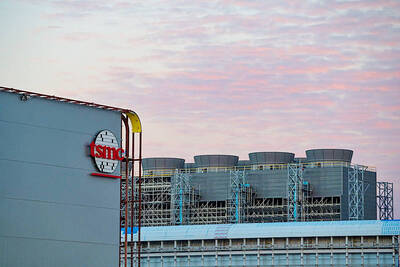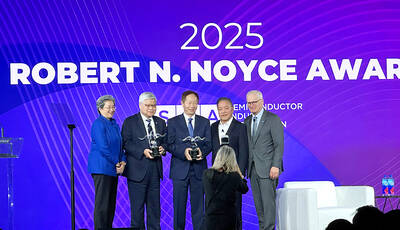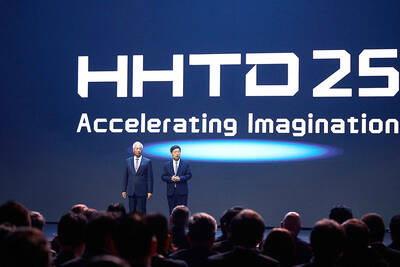Google Inc’s secretive research laboratory is trying to build a fleet of drones designed to bypass earthbound traffic so packages can be delivered more quickly.
The ambitious program announced on Thursday escalates Google’s technological arms race with its rival Amazon.com Inc, which is also experimenting with self-flying vehicles to carry merchandise bought by customers at its online store.
Amazon is mounting its own challenges to Google in online video, digital advertising and mobile computing in a battle that also involves Apple Inc.
Google calls its foray into drones “Project Wing.”
Although Google expects it to take several more years before its fleet of drones is fully operational, the company says test flights in Australia delivered a first aid kit, candy bars, dog treats and water to two farmers after traveling a distance of about 1km two weeks ago. Google’s video of the test flight, set to the strains of the 1969 song Spirit In The Sky, can be seen at www.youtube.com/watch?v=cRTNvWcx9Oo.
Besides perfecting their aerial technology, Google and Amazon still need to gain government approval to fly commercial drones in many countries, including the US.
Amazon last month asked the US Federal Aviation Administration for permission to expand its drone testing. The administration allows hobbyists and model aircraft makers to fly drones, but commercial use is mostly banned.
Project Wing is the latest venture to emerge from the Google X lab, which has also been working on self-driving cars as well as other innovations that company chief executive officer Larry Page likens to “moonshots.” The lab’s other inventions include the Internet-connected eyewear Google Glass, Internet-beaming balloons called “Project Loon” and a high-tech contact lens that monitors glucose levels in diabetics.
A team led by Massachusetts Institute of Technology aeronautics professor Nick Roy has been working on Project Wing for two years, according to Google. The Mountain View, California-based company did not disclose how much the project has cost.
Drones clearly could help Google expand an existing service that delivers goods purchased online on the day that they were ordered. Google so far is offering the same-day delivery service by automobile in parts of the San Francisco Bay Area, Los Angeles and New York.
“Self-flying vehicles could open up entirely new approaches to moving goods, including options that are cheaper, faster, less wasteful and more environmentally sensitive than what’s possible today,” a pamphlet released by Google outlining Project Wing said.
Google seems to see its drones as something more than another step in e-commerce delivery.
The aerial vehicles could also make it easier for people to share certain items, such as a power drill, that they may only need periodically.
They could deliver emergency supplies to areas damaged by earthquakes, hurricanes and other natural catastrophes, according to Google’s Project Wing pamphlet.

Shiina Ito has had fewer Chinese customers at her Tokyo jewelry shop since Beijing issued a travel warning in the wake of a diplomatic spat, but she said she was not concerned. A souring of Tokyo-Beijing relations this month, following remarks by Japanese Prime Minister Sanae Takaichi about Taiwan, has fueled concerns about the impact on the ritzy boutiques, noodle joints and hotels where holidaymakers spend their cash. However, businesses in Tokyo largely shrugged off any anxiety. “Since there are fewer Chinese customers, it’s become a bit easier for Japanese shoppers to visit, so our sales haven’t really dropped,” Ito

The number of Taiwanese working in the US rose to a record high of 137,000 last year, driven largely by Taiwan Semiconductor Manufacturing Co’s (TSMC, 台積電) rapid overseas expansion, according to government data released yesterday. A total of 666,000 Taiwanese nationals were employed abroad last year, an increase of 45,000 from 2023 and the highest level since the COVID-19 pandemic, data from the Directorate-General of Budget, Accounting and Statistics (DGBAS) showed. Overseas employment had steadily increased between 2009 and 2019, peaking at 739,000, before plunging to 319,000 in 2021 amid US-China trade tensions, global supply chain shifts, reshoring by Taiwanese companies and

Taiwan Semiconductor Manufacturing Co (TSMC) Chairman C.C. Wei (魏哲家) and the company’s former chairman, Mark Liu (劉德音), both received the Robert N. Noyce Award -- the semiconductor industry’s highest honor -- in San Jose, California, on Thursday (local time). Speaking at the award event, Liu, who retired last year, expressed gratitude to his wife, his dissertation advisor at the University of California, Berkeley, his supervisors at AT&T Bell Laboratories -- where he worked on optical fiber communication systems before joining TSMC, TSMC partners, and industry colleagues. Liu said that working alongside TSMC

TECHNOLOGY DAY: The Taiwanese firm is also setting up a joint venture with Alphabet Inc on robots and plans to establish a firm in Japan to produce Model A EVs Manufacturing giant Hon Hai Precision Industry Co (鴻海精密) yesterday announced a collaboration with ChatGPT developer OpenAI to build next-generation artificial intelligence (AI) infrastructure and strengthen its local supply chain in the US to accelerate the deployment of advanced AI systems. Building such an infrastructure in the US is crucial for strengthening local supply chains and supporting the US in maintaining its leading position in the AI domain, Hon Hai said in a statement. Through the collaboration, OpenAI would share its insights into emerging hardware needs in the AI industry with Hon Hai to support the company’s design and development work, as well